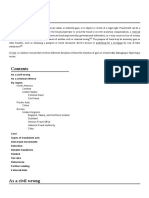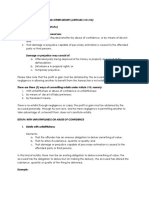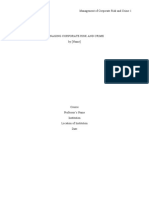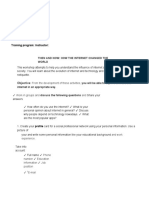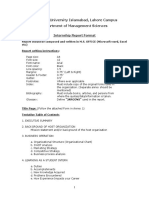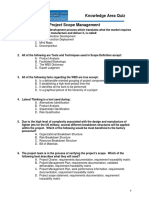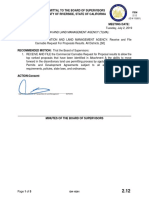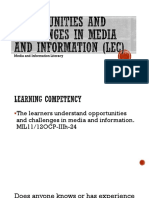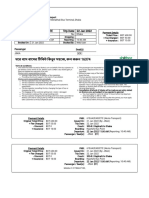A Deep Look at the UAE Law against Fraud
by Khalid Al Hamrani - k.hamrani@tamimi.com - Dubai International Financial CentreMohamed El Deessouky - m.dessouky@tamimi.com - Dubai, UAEApril 2017Hand-in-hand with the virtually continuous development of economic activity within the UAE, therehas been a steady rise in the complexity of commercial transactions.This is a natural by-product of an economy that has been stimulated by massive investment andmanaged by large-scale economic entities and financial institutions. Growing wealth and prosperitynaturally encourages increases in criminal activity, particularly crimes involving seemingly-normalcommercial transactions. In this article, we shed light on an example of a common criminal activity:fraud. Article 399 of UAE Federal Law No. 3 of 1987, as amended, (the ‘Penal Code’) stipulates that:‘Whoever captures for himself or for others transferable money or documents or signing suchdocument or cancelling, damaging or amending it through trickery or using a false name orpersonality for the purpose of tricking the victim and forcing him to deliver such shall be punishedwith a jail or a fine.The same penalty shall be applied to whoever disposes of a building or a movable that he knowshe does not own or that he has no right to dispose of such or who disposes of anything of the samekind with the knowledge that another person has disposed of such or contracted on and hence heshall harm the other.The attempt shall be punished with a jail for a period not exceeding two years or a fine notexceeding ten thousand dirhams.’The layman’s understanding of fraud is that it is an offence that involves deception; however, theelements of the crime are more nuanced. The act of fraud, under UAE law, is the act of acquiring orreceiving, through fraudulent means, money, moveable goods, or immoveable real property that isowned by another person. Those means, to be fraudulent, have to convince the victim to surrenderthe money, goods, or property to the offender. While deception is a necessary aspect of fraud, it isnot sufficient in and of itself to establish the offence. Fraud is only considered to have occurredwhen the act has involved both deceit and the use of fraudulent means to obtain property or assets.
Deceit and fraud distinguished
These requirements are reflected in the decision of the Dubai Court of Cassation in judgment 19 of1995. In that case, the Court stipulated that the act of lying on its own does not lead to theestablishment of fraud. Both deceit and fraudulent means to obtain property or assets had to beestablished for the offence to have occurred. ‘Merely false sayings and allegations are not sufficientfor fraudulent means to take place. Lying should be accompanied with material acts or externalappearances [that] cause the victim to believe in the truth of the lie and to surrender his money as aresult of such belief’, the Court explained.The element of the offence, ‘using fraudulent means’, is defined by Article 399 of the Penal Codeas constituting any of the following actions committed with the intention of deceiving others:
using a false name or acting in a false capacity;
disposing of money, or moveable or immoveable property, while knowing that it is not the
disposer’s property or that he is not entitled to dispose of the same; orfalsely imitating an act previously carried out by another.
These acts are not only characterised as being deceitful but are also defined as using externalinstruments for the purpose of supporting the act of fraud.
Requirement of an ‘external instrument’
An external instrument, in this sense, refers to measures taken to lend credibility to the deceptioninvolved in the fraud. For instance, a criminal may establish a fraudulent company, openheadquarters, appoint support staff, and take other steps to create the illusion of a legitimatebusiness. Constructing an appearance of legitimacy confers a level of trust that makes it easier tocoerce funds from victims. Commonly fabricated qualities include appearances of wealth,professionalism, or morality to encourage greater levels of trust.External instruments or appearances can be used in other ways, depending on the type of fraud inquestion. For example, they can also be used to convince a victim of the occurrence of a falseincident, as is common in insurance fraud. For example, a criminal may commit arson to obtain themonetary value of an insured property or conceal the whereabouts of a vehicle before claiming thatit had been stolen.Where a fraudster is assisted by another person in carrying out a deceit, the use of an accompliceis also deemed an external instrument and constitutes fraud. According to the Dubai Court ofCassation in a judgment dated 12/03/2005, in Challenge No. 1/2005 Penal Code, however, theaccomplice is only considered an external instrument if their participation was ‘a result of the effort,intention, and organisation of the criminal’ and was not independently solicited by the accomplice.The accomplices support and intervention will be considered when evaluating the criminal’s lying toa crime of fraud.
Abuse of position
The act of taking a false identity refers to the criminal availing itself of a false identity to provoke adesired response from the victim. For example, a fraudster may pretend to be a lawyer to obtainconfidential information from a victim. It is important to note that, whilst this would be a blatant lie,Article 399 of the Penal Code does not refer to this offence explicitly as identity fraud, but rather assimple fraud.This differs, however, in instances where the fraudster has presented themselves in their truecapacity, but abused the trust associated with the given role in an attempt to convince the victim tosurrender monies. A policeman, for example, may apprehend a victim and convince them of theirobligation to pay a contrived fine. The fraudster has not taken a false identity but has rather abusedtheir position and added certain elements to deceive the victim. In such cases, the judiciary willgenerally consider the misuse of position or office as a form of fraudulent means.
Deceit
Deceit is that which would cause a victim to believe in an untruth, thereby causing an ordinaryperson to surrender property. The test for deceit requires that an ordinary or reasonable personwould be deceived by the misrepresentation. Actions that were too incredible or outlandish do notfall within the scope of the rule.With regards to deceit with the intent of gaining control or disposing of property to which thefraudster has no claim, it is possible for an ordinary lie, without an external instrument, to constitute
a fraud. The law has been framed to encompass the situation where a victim believes in the validityof the financial transaction even though the perpetrator has not made specific misrepresentationson their position or capacity. Even if a false name or capacity has been assumed as part of anordinary lie, without the support of external instruments, such actions are still deceitful and shouldbe punished according to the law of fraud. In these cases, if the victim believes that the accused’sidentity is authentic, without the usual accompanying evidence, the fraudster is still consideredguilty of taking a false name or capacity. It is important to note that deceit may occur in many forms,but wherever it occurs in writing, it may also constitute forgery.
Identifying the victim
The law assists in identifying the true victim of a fraud. The law states that the victim is thepossessor, at the time of the crime, of the object of fraud, such as the money or property stolen,rather than the owner of the property.For instance, consider the position of a couple who have been sold a property by a man claiming tobe a property developer. After signing the deal, it transpires that the man does not in fact own theproperty in question and has disappeared with the couple’s money. In this case, the victims of thefraud are the couple who now have completed an invalid purchase, and not the true owner of thehouse. The true owner is not directly harmed by the crime in the sense of having suffered anydamage, although his compromised right to possess the property would still be considered acriminal harm.The above rules apply in all instances where the fraudster is not in possession of the property thatis subject to a sale, whether it is moveable or immovable in nature. However, if the property ismoveable and the fraudster is the possessor, then the original owner is also a direct victim of thecrime. It is important that the law distinguishes between movable and immovable property and thelaw relating to ownership. In offences relating to immovable property, such as houses, the title ofdeed will constitute proof of the ownership of the building, irrespective of who has control of theproperty. For movable property, or chattels, the individual in control is assumed to be the legalowner until proven otherwise.
The circumstances of the victim
The criminal law takes into account the intention of the victim as well as the perpetrator of fraud,making this element of the offence different from the element of deceit.In cases where the fraud involves the victim committing an illegal offence, the criminality of thevictim does not absolve the fraudulent nature of the act. For example, if a perpetrator assumes therole of an arms dealer to broker a transfer of stolen weapons to a victim who intends to use theweapons for a criminal purpose but disappears with the payment monies before the weapons havebeen handed over, a fraudulent scheme has still taken place, and the illicit nature of the victims’activity does not prevent them from being victims.To avoid being classified as fraud, the conditions that are used to persuade the victim to surrendermoney must be correct and devoid of any falsification. In the Court authority cited above, thedefendants used the victim’s prior knowledge of an existing case of theft in the area to convince thevictim of an imminent risk of robbery and attack. The use of such information, by itself, does notconstitute a fraudulent act.
Conclusion
Individuals and companies should be careful when dealing with other parties in transactionsinvolving the transfer of funds or properties. Parties must verify powers, ownership, and other lawfulcapacities before concluding any transaction. It is not sufficient simply to rely on the appearance of
any counter party or to make assumptions as to the other party’s powers.Learn how our Financial Crime practices offer law assistance for matters relating to fraud in theUAE.

















